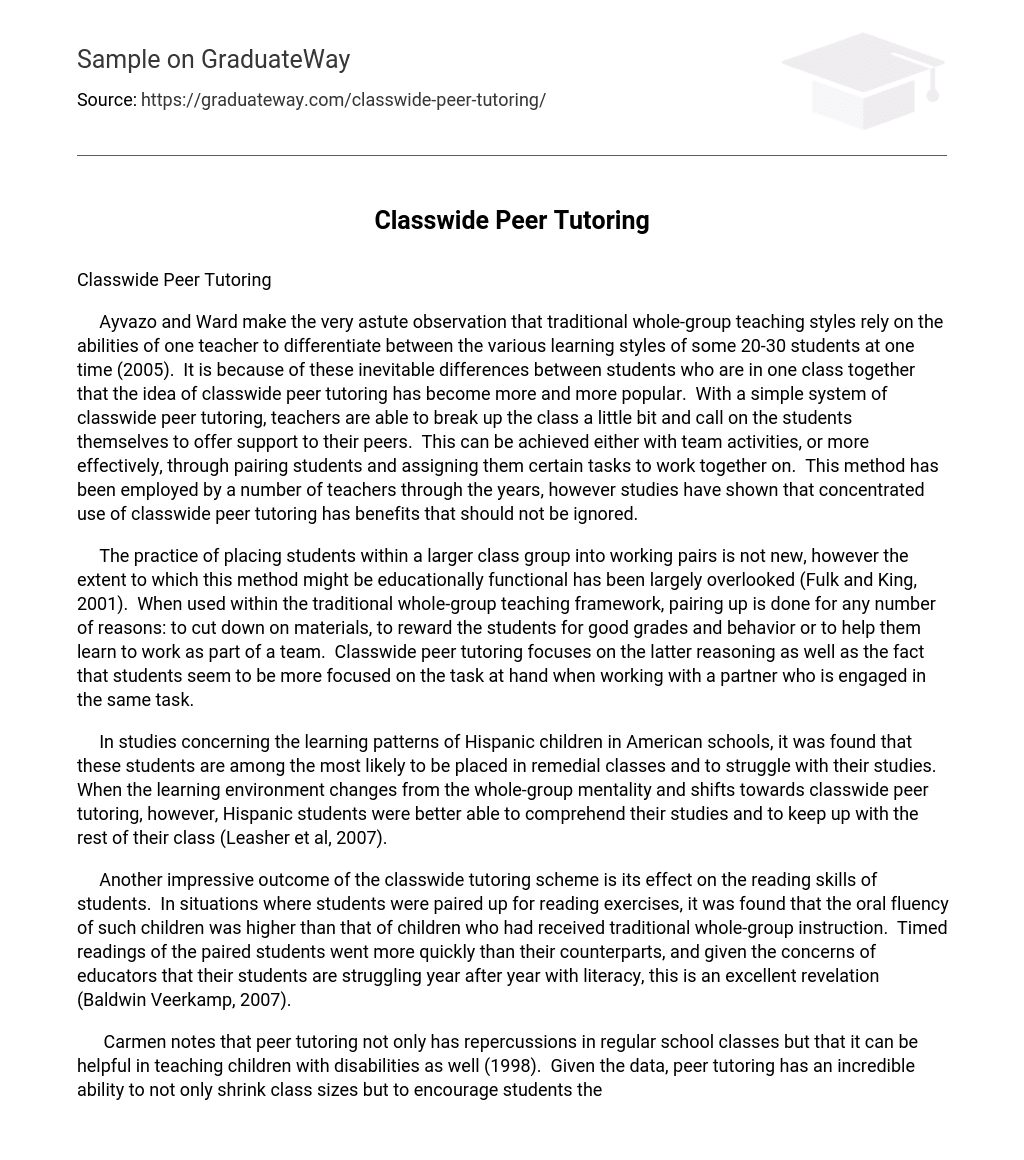Ayvazo and Ward make the very astute observation that traditional whole-group teaching styles rely on the abilities of one teacher to differentiate between the various learning styles of some 20-30 students at one time (2005). It is because of these inevitable differences between students who are in one class together that the idea of classwide peer tutoring has become more and more popular.
With a simple system of classwide peer tutoring, teachers are able to break up the class a little bit and call on the students themselves to offer support to their peers. This can be achieved either with team activities, or more effectively, through pairing students and assigning them certain tasks to work together on. This method has been employed by a number of teachers through the years, however studies have shown that concentrated use of classwide peer tutoring has benefits that should not be ignored.
The practice of placing students within a larger class group into working pairs is not new, however the extent to which this method might be educationally functional has been largely overlooked (Fulk and King, 2001). When used within the traditional whole-group teaching framework, pairing up is done for any number of reasons: to cut down on materials, to reward the students for good grades and behavior or to help them learn to work as part of a team. Classwide peer tutoring focuses on the latter reasoning as well as the fact that students seem to be more focused on the task at hand when working with a partner who is engaged in the same task.
In studies concerning the learning patterns of Hispanic children in American schools, it was found that these students are among the most likely to be placed in remedial classes and to struggle with their studies. When the learning environment changes from the whole-group mentality and shifts towards classwide peer tutoring, however, Hispanic students were better able to comprehend their studies and to keep up with the rest of their class (Leasher et al, 2007).
Another impressive outcome of the classwide tutoring scheme is its effect on the reading skills of students. In situations where students were paired up for reading exercises, it was found that the oral fluency of such children was higher than that of children who had received traditional whole-group instruction. Timed readings of the paired students went more quickly than their counterparts, and given the concerns of educators that their students are struggling year after year with literacy, this is an excellent revelation (Baldwin Veerkamp, 2007).
Carmen notes that peer tutoring not only has repercussions in regular school classes but that it can be helpful in teaching children with disabilities as well (1998). Given the data, peer tutoring has an incredible ability to not only shrink class sizes but to encourage students themselves to take responsibility for their own learning and the support of another student. Given the growing classrooms of the United States, the practical benefits of classwide peer tutoring aren’t difficult to recognize.
Reference
- Ayvazo, Shiri, Philip Ward. Effects of Classwide Peer Tutoring on the Catching Performance of Children With and Without Autism in Physical Education. (2005). Research Quarterly for Exercise and Sport: Research Consortium Abstracts, 76(1), A112. Retrieved October 2, 2007, from Research Library database. (Document ID: 804362371).
- Baldwin Veerkamp, Mary, Debra M Kamps, Lori Cooper. (2007). The Effects of Classwide Peer Tutoring on the Reading Achievement of Urban Middle School Students. Education & Treatment of Children, 30(2), 21-51. Retrieved October 2, 2007, from ProQuest Psychology Journals database. (Document ID: 1328616241).
- Barbara M Fulk, Kathy King. (2001). Classwide peer tutoring at work. Teaching Exceptional Children, 34(2), 49. Retrieved October 2, 2007, from ProQuest Education Journals database. (Document ID: 90911530).
- Carmen Arreaga-Mayer (1998). Increasing active student responding and improving academic performance through classwide peer tutoring. Intervention in School and Clinic, 34(2), 89. Retrieved October 2, 2007, from Research Library database. (Document ID: 35764675).
- Leasher Dennis Madrid, Madeline Canas, Mona Ortega-Medina. (2007). Effects of Team Competition Versus Team Cooperation in Classwide Peer Tutoring. The Journal of Educational Research, 100(3), 155-160,192. Retrieved October 2, 2007, from ProQuest Psychology Journals database. (Document ID: 1214294421).





